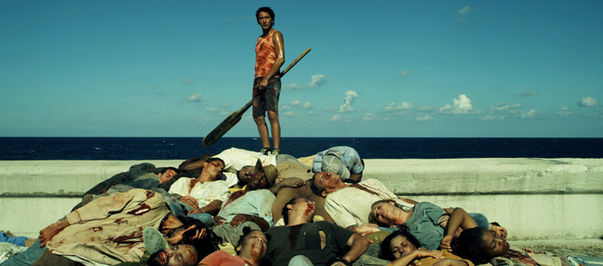The Latin-American metaphor of the living dead.
Talent Press Guadalajara participant Luis Vaca reviews Alejandro Brugués’ Cuban zombie parable JUAN OF THE DEAD.

Alejandro Brugués’ JUAN OF THE DEAD
For a better contextualization of the image of the zombie for the collective imagery, I will go back to the famous movie NIGHT OF THE LIVING DEAD by George A. Romero (1968). Even though it was filmed during the Vietnam War, this movie is not a metaphor of any political, social or cultural problem. In spite of the several films on the same topic, the title mentioned above triggered the cult for zombie films.
With NIGHT OF THE LIVING DEAD, the image of zombies became popular around the globe, and twenty-five years later, in 1985, the genre would renew and take a new path linked with the social situation of the time. This is why Dan O’Bannon’s RETURN OF THE LIVING DEAD appears distant from horror, closer to parody; a low budget production in which a new generation, keen on horror creatures, would look for the satisfaction of new concerns. During this new wave special effects, from kitsch to unlikely, the stories were told in a very simple way, with a very light humor. In 2004’s SHAUN OF THE DEAD, director Edgar Wright reaches unlikeliness, as hordes of zombies appear as a plague and the story focuses on the diverse ways to exterminate them; starting from martial arts and even ranging to flamethrowers being the preferred tool to exterminate this unloving beings.
I am interested in this topic not only because of the relevance of the subject for the collective imagery for constructing a zombie archetype, but also because this formula has been used for years to make this metaphor more complex, more interesting. It is all about this faculty-less beings which are not completely death, which can walk, fight, but not think. JUAN OF THE DEAD is more of a black comedy than a horror film; it is a movie that responds to both formulas. Zombies become a parody to question the values of Castro’s Cuba, but there’s still a particular nationalism embedded in Juan.
It is important to emphasize that the cult for zombies is a result of the videogame phenomenon in which these creatures have a fundamental role as well as in comics and animation. This trend dates back from RETURN OF THE LIVING DEAD and afterward SHAUN OF THE DEAD. At the end of JUAN OF THE DEAD we appreciate a sort of image which respond to this tradition of illustrating shocking or action scenes. The zombie killer is “immortalized” in a grotesque way beside American heroes, the legacy of the great depression – they were also used as a metaphor of the American conventional values.
Except for the image of the famous Mexican luchador “El Santo” against the living dead, zombie cinema is not part of the Latin American culture; however, it is a genre with millions of enthusiasts all over Latin America. JUAN OF THE DEAD tackles the subject of the zombies through a chaotic story in which the characters are part of a group of exterminators with Juan at the head. They seem not to be impressed by the way this pest expands and they never wonder where this curse comes from, they only make fun of the official reports saying it is a Yankee conspiracy.
With a very noisy humor and a nonsense construction, this movie is very agile, the freshness of the script avoids the loss of interest because of the hyperbolic hemorrhages of thousands of zombies. As I mentioned before, a low budget and a not very detailed revision are fundamental aspects of the tradition of this genre. The interesting point of the film is the reaction to a zombie invasion, which is not as different as we might think, considering that JUAN OF THE DEAD and SHAUN OF THE DEAD are productions of countries that do have an antagonist posture towards each other.
Finally, this film is a pioneer in our continent. There is no doubt that JUAN OF THE DEAD is a (very Latin) reinterpretation of the image of the zombie as a reflection of social discontent. Call it dissident, call it Yankee or Castro, the zombie represents a lack of ideas and an interest for satisfying basic needs, like eating a brain or contaminating the rest of the population of a tough restriction. This is the reason for the fascination with this creature, that can convert the population into zombies and the only way out of the tragedy is parody.

